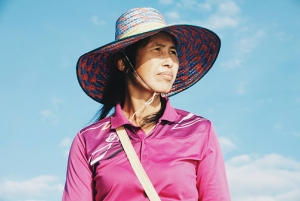Roots in the water
Engaging children in mangrove conservation
Location: Bangkok, Thailand. 12th Apr 2018
For the people of Trat province in Thailand, the sea is everything. Like many people in the Mai Rood community, Wanida’s father owned a large fishing boat and would be out at sea for days.

Wanida Tongboonma, Science Teacher at Ban Mai Rood School © Siriporn Sriaram/MFF
As a child, Wanida also used to go fishing, navigating her much smaller boat through the canals and along the shoreline, developing her connection with the mangrove forests.
“Many people are unaware of the benefits provided by mangroves, and illegally cut them down to replace with shrimp ponds or plantations.” – Wanida Tongboonma

Mangrove’s line the canals surrounding Mai Rood. © Ana Grillo/MFF
Mangrove forests are essential to the health and balance of coastal ecosystems around the world. They protect our coasts, insulating them against rising waters, erosion, and devastating natural disasters like the 2004 Indian Ocean tsunami. Mangroves also provide a safe place for a vast number of aquatic animals to be born and mature, and sustain indispensable plant species; millions of people depend on mangrove ecosystems for food, shelter, commerce, and traditional medicines.
When mangroves are degraded, fish populations drop. Wastewater pollution, overfishing and the destructive gear used by fishing trawlers and dredging boats make the decline more drastic.
In the fishing community of Mai Rood, more than 1,000 households rely directly on coastal resources and ecosystems for their livelihood. At Ban Mai Rood school, where Wanida teaches science, most students are from fishing families.
“The children can influence their parents by engaging them in conservation activities.” - Wanida
One morning, after witnessing black sludge draining from a fish pond into the nearby mangrove canal, Wanida asked her students what they knew about the negative impacts of shrimp aquaculture on mangrove ecosystems. Many of the students knew very little, and also weren’t aware of the importance of these forests to the livelihoods of their families and friends.

Wanida became a mangrove advocate among the local students and communities in Mai Rood © Alex Macwilliam/MFF
Determined to change this, Wanida decided that issues of mangrove degradation and conservation needed to be incorporated into Ban Mai Rood’s science curriculum. The school’s unique location right next to the canal and mangrove forests would provide the perfect opportunity for students to learn about the precious ecosystem in their own backyard.
In 2016, Wanida and her fellow teachers secured funding from MFF to implement a project called the Mai Rood Mangrove Conservation Partnership. The project aimed to enhance knowledge and awareness of mangrove conservation among schools and communities in the area.
It was not without its challenges. After receiving MFF funding, disagreements about how the funds should be utilised threatened to stop the project before it had even begun. Determined to see the project succeed, however, Wanida stuck to her principles, and after a long battle, successfully negotiated to have the project implemented as intended.
Through the partnership established by the project, Wanida invited four other schools from Klong Yai District to participate in the development of the Mangrove Conservation and Environment Curriculum for Grade 6 students. The curriculum was approved by the school board and integrated, giving students the opportunity to learn about mangroves, coastal biodiversity, and the variety of challenges to the conservation of those ecosystems. More than 500 students at Mai Rood were taught from the curriculum, which was then extended to the four schools in Klong Yai.
As part of the curriculum, the students learned about biodiversity in mangrove forests, the important role that mangroves play in sustaining local livelihoods, and how to help conserve the ecosystem. With support from the Department of Marine and Coastal Resources (DCMR), students also attended a workshop on mangrove ecosystems and the environment.
To put what they had learned into practice, the school helped the students establish a small nursery where they could raise mangrove seedlings, which they then planted along the canal in areas where mangroves had been cut down.
Building on the success of the project, the DMCR is now including students from the school in regular surveys to monitor mangroves in Mai Rood.

Wanida (far right) and students during one of their many visits to the school nursery. © Alex Macwilliam/MFF
Our children are our future. Only through education on the importance of their local environment will they be able to navigate towards one in which people coexist with nature. Equipped with the right resources, educators like Wanida can help guide them in the right direction.
View the multimedia story here.

Wanida, Trat, Thailand © Siriporn Sriaram, 2018